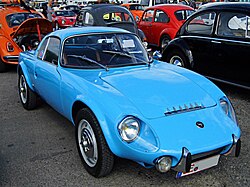Matra Djet
| Matra | |
|---|---|
|
Djet V
|
|
| Djet | |
| Production period: | 1962-1968 |
| Class : | Sports car |
| Body versions : | Coupe |
| Engines: |
Petrol engines : 1.1-1.3 liters (51-77 kW) |
| Length: | 3900-4200 mm |
| Width: | 1250-1400 mm |
| Height: | 1150-1200 mm |
| Wheelbase : | 2400 mm |
| Empty weight : | |
| successor | Matra 530 |
The Matra DJET was a sports coupé from the automobile manufacturer Matra .
René Bonnet DJET 1962 to 1964 / Matra JET 1964 to 1968
The history of the Djet goes back to the designer René Bonnet . In 1962, Bonnet worked on the mid-engined Djet and a Formula 3 car. The French company Matra only appeared as a sponsor . But in October 1964 Bonnet ran into financial difficulties and Matra became an automobile manufacturer, partly to bring back the money, partly to make the name known and not least out of enthusiasm for sports. As early as 1965, Matra immediately won the Formula 3 championship in France. Four years later, Matra was Formula 1 world champion. After the takeover by MATRA, only the Djet was built, now under the name Matra Jet. Bonnet only worked for Matra for three months, then the Simca engineer Philippe Guedon switched to Matra. The jet was further developed until 1967, when the Matra 530 came onto the market.
Technical specifications
- Engine: Renault 8 (Gordini) water-cooled four-cylinder four-stroke engine, lengthways in front of the rear axle. Camshaft drive via timing chain, valve control via tappets, bumpers and rocker arms, Zenith or two Solex double carburettors
- Displacement: 1108 cm³ / 1255 cm³
- Power: 70 (Djet 5) to 105 HP (Jet 6)
- Transmission: four-speed, fully synchronized
- Chassis: Central tubular frame with additional tubular framework on the axles
- Body: plastic on platform frame
- Front axle: independent suspension on double wishbones, coil springs, stabilizer and telescopic dampers
- Rear axle: swing axle
- Dimensions up to October 1964: 3900 × 1400 × 1150 mm (René Bonnet)
- Dimensions from October 1964: 4200 × 1250 × 1200 mm
- Wheelbase: 2400 mm
- Top speed: up to 210 km / h (Jet 6; factory specification)
- Construction time: 1962 to 1968
- Number of items: 1689 (including 198 René Bonnet)

